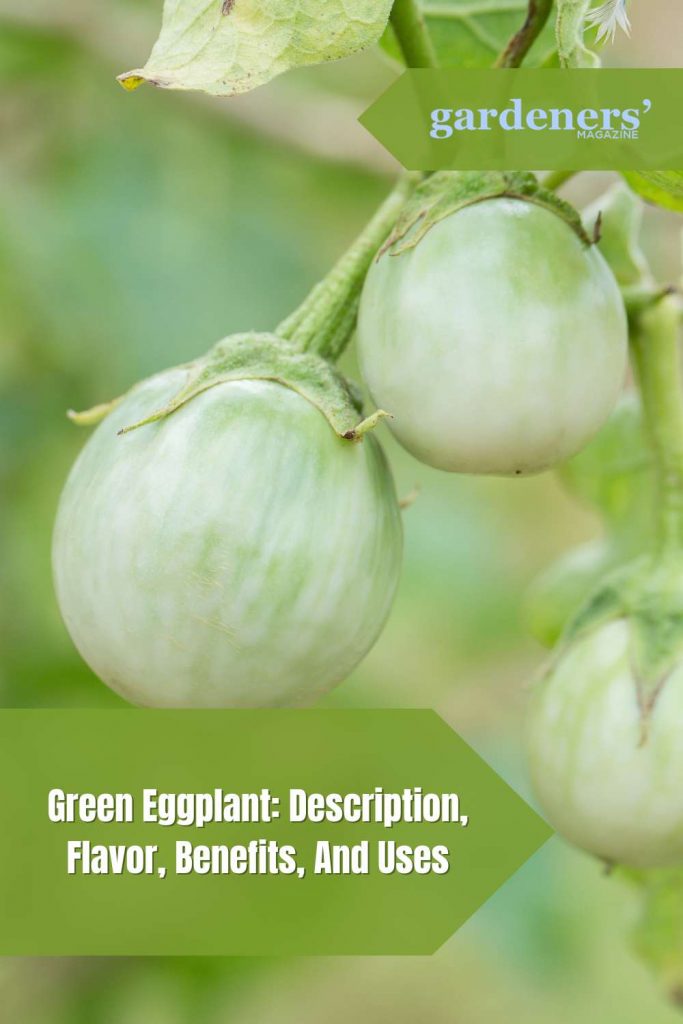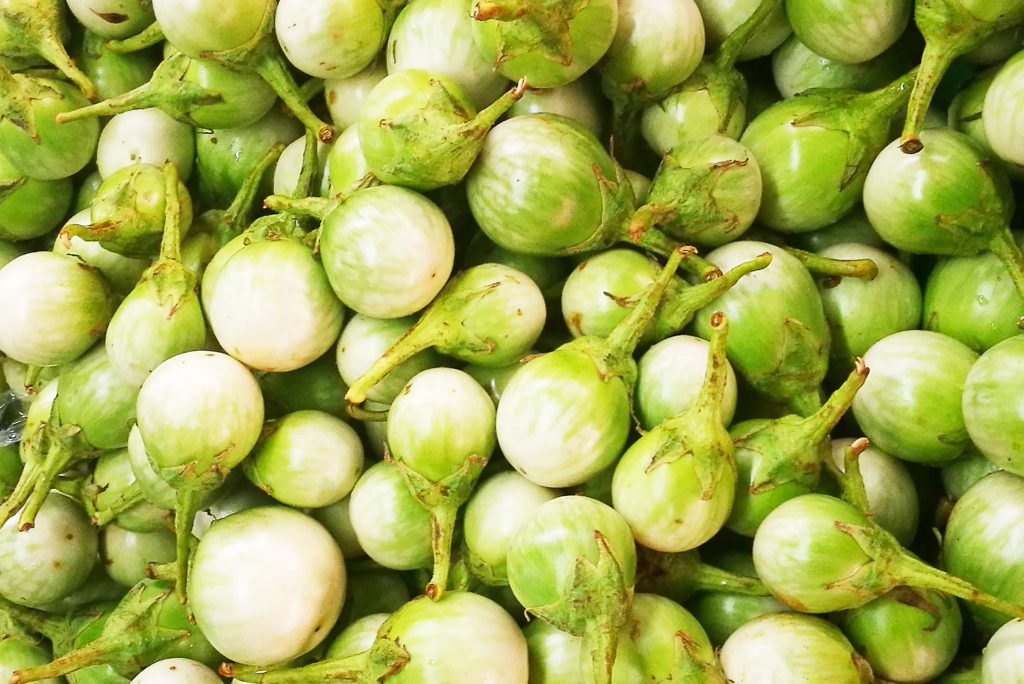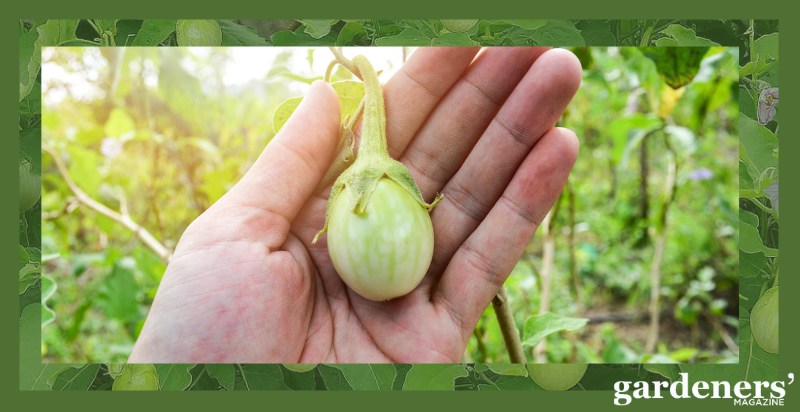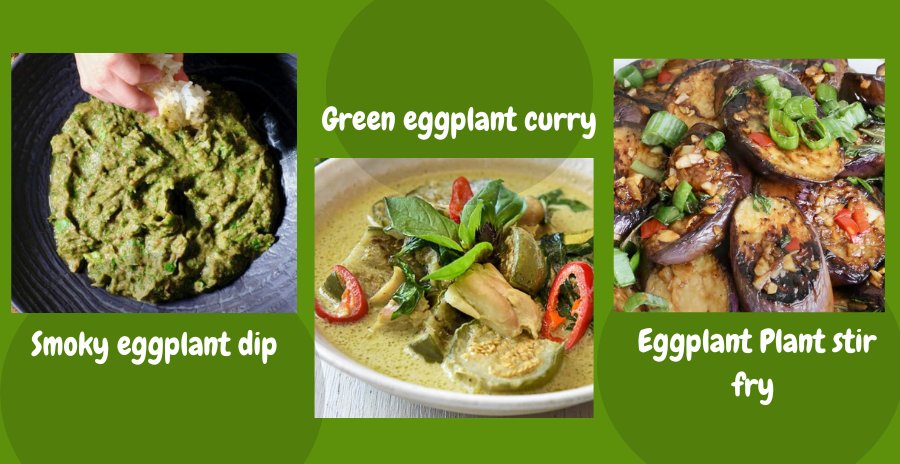Known botanically as Solanum melongena, this variety of eggplant stands out for its vibrant green hue, which ranges from light to dark shades, sometimes speckled with white patches. Unlike its more common purple counterpart, Green Eggplant offers a milder and sweeter flavor profile, making it a delightful addition to a variety of dishes. Its texture, when cooked, becomes tender and creamy, making it perfect for absorbing the flavors of spices and sauces.
In the garden, Green Eggplant is as rewarding to grow as it is to cook. It thrives in warm climates and requires consistent moisture and well-drained soil. As it matures, the plant produces attractive, glossy fruits that are not only delicious but also add ornamental value to your vegetable garden. Whether you’re a seasoned gardener or a beginner, growing Green Eggplant can be a fulfilling experience, offering both culinary delights and the joy of nurturing a plant from seed to harvest.
What is Green Eggplant?
Green eggplant is a type of vegetable that belongs to the nightshade family. It has a unique, round shape and is usually bright green. What sets the Green Eggplant apart from its more familiar purple relative is its flavor profile. It tends to have a milder, sweeter taste, which makes it a versatile and appealing ingredient in a variety of culinary creations. When cooked, Green Eggplant transforms into a tender, creamy delight, adept at absorbing and complementing the flavors of spices and sauces in dishes.
From a gardening perspective, Green Eggplant is a rewarding plant to grow. It thrives in warm, sunny conditions and requires consistent watering and well-draining soil to flourish. As the plant matures, it produces glossy, attractive fruits that are not only delicious to eat but also add a decorative touch to your vegetable garden. Growing it offers a unique gardening experience, allowing you to enjoy both the process of nurturing the plant from seed to fruit and the culinary adventures that follow the harvest.

History and Origin of Green Eggplant:
Eggplants are believed to have originated in India, where they grew in the wild. They have been cultivated in South and East Asia since prehistoric times. The ancient ancestors of the eggplant were likely quite bitter, leading to a gradual process of cultivation and selective breeding to produce the more palatable varieties we know today, including the Green Eggplant.
From India, the cultivation of eggplants spread to China and then throughout Asia. Historical records suggest that eggplants were being cultivated in China by the 5th century. The Arab traders in the Middle Ages were responsible for introducing eggplants to the Mediterranean region, from where they spread to Europe.
The Green Eggplant, with its unique color and milder flavor, is a result of this long history of cultivation and selective breeding. It’s particularly popular in Southeast Asian and East Asian cuisines, where it’s valued for its texture and ability to absorb flavors. In these regions, different varieties of Green Eggplants have been developed, each adapted to the local culinary and agricultural conditions.
Today, green eggplant is a popular vegetable in many cuisines worldwide, particularly those of Indian, Southeast Asian, Mediterranean, and African cultures. Green eggplants are often used as a main ingredient in curries, stews, stir-fries, soups, salads, pizzas, and desserts.
Description of the Green Eggplant:
Green Eggplant, scientifically known as Solanum melongena, has a length of around 15-20 cm, and the diameter is typically 5-7 cm. It is a distinctive and appealing variety of the common eggplant. It’s particularly noted for its vibrant green color, which can range from a pale, almost lime green to a deeper, forest green. Sometimes, these eggplants also feature charming white speckles or stripes, adding to their visual appeal.
In terms of size and shape, Green Eggplants can vary quite a bit. The Green Eggplant has a length of around 15-20 cm, and the diameter is typically 5-7 cm, resembling a large tomato, but in longer and more cylindrical forms, similar to the traditional purple eggplant. The skin of the Green Eggplant is smooth, glossy, and slightly waxy to the touch.
Flavor Profile of Green Eggplant:
One of the most notable aspects of the green eggplant’s flavor is its inherent mildness. It lacks the intensity and, sometimes, bitterness associated with traditional purple eggplants. This milder taste makes it a versatile ingredient in the kitchen. Green eggplants often have a subtle earthy undertone, which adds depth to their overall flavor. This earthiness is not overpowering but rather complements the vegetable’s natural sweetness. While not a flavor per se, the texture of green eggplant contributes significantly to its culinary profile. Some green eggplant varieties may have a faintly nutty taste, especially when cooked. This nuance adds an extra layer of complexity to dishes.
When cooked, the flavor is intensified and becomes more complex with stronger notes of sweetness and bitterness. These unique flavor notes make Green Eggplant a popular choice for many dishes. Its mild flavor pairs well with more pungent ingredients such as garlic, onions, and herbs, creating an interesting contrast of flavors.

Health Benefits of Green Eggplant:
Green eggplants are low in calories but rich in a variety of nutrients. They contain vitamins like vitamin C and B vitamins, essential for immune function and energy metabolism, respectively. The high fiber content in green eggplants is beneficial for digestive health. It aids in bowel regularity and can help prevent constipation.
Additionally, it contributes to a feeling of fullness, which can be helpful for weight management. Fiber also slows the rate of digestion and sugar absorption in the bloodstream, helping to prevent spikes in blood sugar.
Eggplants are rich in antioxidants, particularly nasunin found in the skin of the eggplant, which is a type of anthocyanin. These antioxidants help protect the body against oxidative stress and are important for overall health. The fiber, potassium, vitamin C, vitamin B6, and antioxidants in green eggplants all support heart health. Potassium helps regulate blood pressure, while fiber can help lower blood cholesterol levels, reducing the risk of heart disease.
Finally, these also contain phytonutrients such as phenolic compounds and flavonoids which can help reduce inflammation and provide other health benefits.
Cultivation of the Green Eggplant:
Green Eggplants thrive in warm, sunny environments. They are typically grown in regions with long, warm growing seasons. Start planting after the last frost when the soil has warmed up, as eggplants are sensitive to cold. Make sure the plants get 6 to 8 hours of direct sunlight every day. If you’re growing them in pots, rotate the pots regularly to ensure all sides of the plant get enough sunlight. Green Eggplants grow best in temperatures between 70°F and 85°F (21°C and 29°C). Temperatures below 50°F (10°C) can harm the plants, while extreme heat can also be detrimental.
These plants require organic-rich, well-draining soil. The ideal soil pH for eggplants is slightly acidic to neutral (pH 5.5 to 7). Before planting, it’s beneficial to enrich the soil with compost or a balanced fertilizer.
Seeds should be planted 1/2″ deep and around 18″ apart. Water thoroughly to ensure that the soil is evenly moist but not soggy. Green eggplants should be fertilized every 3–4 weeks with a balanced fertilizer such as 10-10-10 or 8-8-8. It is important to avoid over fertilizing, as this can lead to stunted plant growth and poor yields.
Harvesting of the Green Eggplant:
It’s important to harvest green eggplants at the appropriate time. Depending on the type and growing circumstances, they are usually available for harvesting 16 to 24 weeks after seeding. The fruit’s size and color serve as the primary indicators. They should be firm, glossy, and have reached their full color, which varies from light to dark green depending on the variety. Press the skin gently with your thumb. The eggplant is ready if it slightly dips but then bounces back.
Cut the eggplant off the vine using pruning shears or a sharp knife. Both the plant and the fruit could become damaged if they are pulled. Maintain a short stem segment adhered to the fruit. Because they bruise readily, handle eggplants with care. Bruised areas are prone to discoloration and degradation very quickly. When harvesting, keep green eggplants in a cool, dry area if you won’t be using them right away. They can be refrigerated for a brief while, but extended cold storage can change their flavor and texture.

Where Does Green Eggplant Grow?
It is native to Asia and can grow in many parts of the continent. It grows wild in India, Pakistan, Nepal, Bangladesh, Burma, Thailand, Laos, Vietnam, and China. It has even been declared an invasive species in some parts of India and Nepal. It is widely cultivated in other regions, such as Japan, Korea, and Taiwan.
In USA, Florida, Texas, Georgia, and the Carolinas provide an optimal environment for eggplant cultivation, thanks to their extended periods of hot summer weather. This type of climate contributes to a longer growing season. In states such as California, Arizona, and New Mexico, the combination of warmth and dryness creates favorable conditions for growing eggplants.
Notably, California stands out for its varied agricultural production and plays a major role in eggplant farming. In the Midwest, states like Illinois and Ohio are also capable of supporting eggplant growth, particularly in the summertime, though their growing seasons tend to be somewhat shorter in comparison to those in the southern states.
Where can the Best Quality Green Eggplant be Brought?
The best-quality Green Eggplant can be found at local farmers’ markets, specialty grocery stores, or online retailers. Farmers’ markets are a great way to find locally-grown produce that has been harvested at peak ripeness. Specialty stores may have organic options and other heirloom varieties of green eggplant. Online retailers offer various green eggplants, including organic and heirloom varieties.
Be sure to read the reviews and descriptions of each item carefully before purchasing. Additionally, some retailers offer special deals or discounts on bulk orders. No matter where you purchase your green eggplant, ensure it has been properly stored and handled and is free from damage or disease.
What are the things you need to keep in mind when buying Green Eggplant?
- Check the color of the eggplant. The ideal color of a green eggplant should be an even, dark green throughout the skin with no discoloration or blemishes.
- Choose an eggplant that is firm and heavy for its size. It should have a glossy surface and feel slightly soft without being overly mushy.
- Avoid eggplants with visible brown spots, bruises, or cuts. The flesh underneath may be discolored, and the eggplant can spoil faster than a fresh one.
- Smell the stem end of the eggplant for a slightly sweet smell; if there is no aroma, it could mean that it was picked before it was ripe.
- Look for freshness when buying green eggplant; the fresher it is, the better it will taste when cooked.
These tips can help you choose the freshest, tastiest green eggplants for your kitchen.
What is the Best Way to Store Green Eggplant?
The best way to store green eggplant is in a cool, dry, and dark location. The ideal temperature for storing eggplants is 10-13°C (50-55°F). Eggplants should be stored away from direct sunlight, as it can cause them to become bitter. When storing eggplants, try to place them in a breathable container, such as a paper bag or a basket. Store the eggplant whole because once it’s cut, it deteriorates quickly. If you have a leftover cut eggplant, wrap it tightly in plastic wrap or place it in an airtight container and refrigerate. Use the cut eggplant as soon as possible.
If you need to store them in the refrigerator, wrap them tightly in plastic wrap first to prevent moisture loss and help keep the eggplants fresh. If kept properly, green eggplant can last up to seven days. To measure for storage purposes, one small eggplant is typically equal to about 8 cm (3 inches) in length.
How to Use Green Eggplant in Recipes?
Green eggplant is a versatile vegetable that can be used in a variety of recipes. It has a mild, salty flavor that pairs well with other fruits and vegetables. Here are some ideas for incorporating green eggplant into your meals:
- Add diced green eggplant to stir-fries along with bell peppers, mushrooms, and carrots for a healthy meal.
- Make a colorful ratatouille by simmering green eggplant, zucchini, tomatoes, and onions in olive oil.
- Sauté cubed green eggplant with garlic, parsley, and basil for a flavorful side dish.
- Puree cooked green eggplant with garlic, lemon juice, and tahini for a tasty dip or spread.
By experimenting with different combinations of fruits and vegetables, you can create delicious meals that feature the wonderful flavors of green eggplant.

Conclusion:
Well, folks, that wraps up our green thumb journey with the charming green eggplant! This little gem is not just a treat for the eyes in your garden but also a delight in your meals with its sweet, mild flavor. Growing it is a breeze in warm weather, and it’s such a joy to see those glossy green beauties pop up. Whether you’re a gardening guru or just starting out, the green eggplant is a fun, rewarding pick.
It’s like having a little piece of culinary magic right in your backyard. So, give it a go, watch those plants flourish, and get ready to whip up some delicious, healthy dishes. Happy gardening and even happier cooking!
- Dino Melons: Description, Flavor, Benefits, And Uses - April 29, 2025
- Pear Trees: Planting, Growing, and Harvesting Pears - March 27, 2024
- Runner Beans (Scarlet Runner Bean): Description, Flavor, Benefits, And Uses - March 21, 2024

5 thoughts on “Green Eggplant: Description, Flavor, Benefits, And Uses”
Comments are closed.